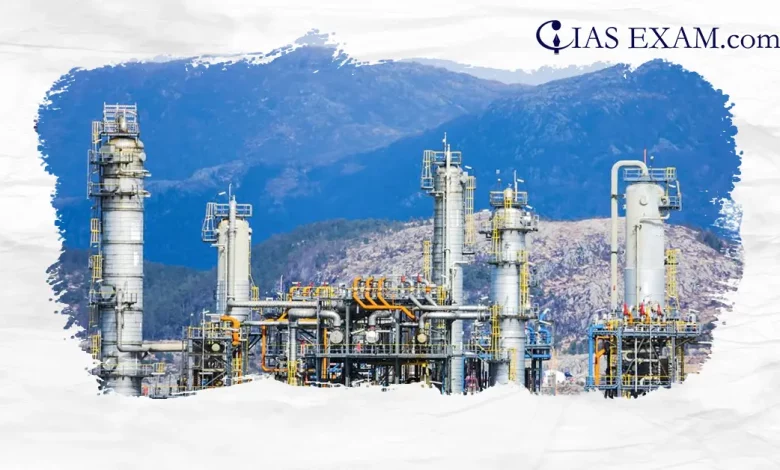Daily Current Affairs for UPSC
CO2 capture and storage to be allowed by Germany on the under-seabed
Syllabus: Ecology & Environment [GS Paper – 3]

Context
- Germany’s Economy Minister Robert Habeck unveiled a new policy proposal intended to enforce this vision. By requiring the country’s CO2 to be sequestered under a layer of water and rock for at least 30 years, or until 2045, companies can remain their own size while remaining neutral on carbon emissions. Industries such as cement are inherently energy intensive.
- Though some progress has been made, an answer is still needed here. The minister proposed a “Carbon Management Strategy” which could be employed to store CO2 in Germany ‘s exclusive economic zone (excluding nature reserves ).
- Greenpeace organisations have criticised this as a setback for clean, renewable energy and an unfair advantage to traditional, fossil fuel-powered firms.
About Carbon Capture and Storage (CCS)
- Carbon Capture and Storage (CCS) is a mechanism to lower carbon emissions, especially for industrial production and electricity generation.
- It seeks to stop global warming. CCS consists of three stages: gathering the carbon dioxide that comes from those sources, transferring it away in most cases using pipelines, and finally storing it deep in geological formations under the ground.
- It is intended to stop CO ₂ from entering the atmosphere, and therefore reduce its effects on global warming.
- CCS starts with capturing CO₂ emissions from sources such as coal and natural gas fired power plants or industrial facilities like steel mills and cement factories.
- Once captured, CO₂ is liquefied through compression in order to make transportation easier. Normally it travels by pipeline but in certain areas (e.g . Europe and Japan), transport may be done by ship.
- Finally, the CO₂ is pumped into geological structures deep underground, normally exhausted oil and gas fields or saline aquifers, for long-term storage. These storage sites typically lie several thousand feet beneath the Earth’s surface.
The Processes involved in CCS
Capture
- There are three ways to achieve the same result: that is to say, eliminate CO2 emissions directly, or carry out a more limited clean up job (e.g., one that might occur at a plant which burns fossil fuels).
- Largely depending on the method, bypass burning of post-combustion, pre-combustion and oxyfuel combustion of fuel from fossil fuels generates CO2 . Post-combustion pulls CO2 out from exhaust gases; pre-combustion captures it together with the fuel before combustion ; while using oxy fuel burning (where air is replaced by pure oxygen) leads to flue gases made almost entirely of water vapour and CO2.
Transport
- Once captured, carbon dioxide (CO2) must be transported and buried. The cheapest, most practical method for moving CO2 is by pipeline.
- This technology is well established and reliable. Should the carbon capture and storage industry develop on a large scale, it is necessary to do more research on pipeline safety in areas of high population density or frequent earthquakes.
- Plan B for less economically viable carbon capture and storage would be ship-borne gasification plants combined with small sea shipping (swapping).
- However, carrying out all of the infrastructure for temporary storage in another location through land-based road tankers leaves a lot more room for flexibility until we can expand the environmentally-friendly energy industry.
Storage
CO2 can be stored in two main ways.
- Deep geological storage is a method of storing carbon dioxide deep underground or in the ocean, which is seen as a promising solution in regions like the North Sea and US Gulf Coast. The IPCC states that properly managed storage sites can retain almost all of the injected CO2 for millions of years.
- Another method, mineral storage, involves reacting CO2 with minerals to prevent its release into the atmosphere, but this process is slow and requires more energy compared to traditional power plants without carbon capture and storage technology.
Conclusion
- Germany has recently signalled a wind down toward absolutely no carbon emissions by 2045 with its approval for capturing carbon underwater for long-term storage.
- Some pressure from Greenpeace, its advocacy network and other similar organisations was offset by others who regarded this initiative as indispensable for countering the general long tail made of hard-to-reduce emissions.
- The introduction of CCS technology will no doubt be met with obstacles, but it is a hopeful start to lower carbon dioxide emissions.
Source: The Indian Express
UPSC Prelims Practice Questions
Q.Consider the following statements regarding Carbon Transportation and Storage.
- The cheapest, most practical method for moving CO2 is by pipeline.
- Deep geological storage is a method of storing carbon dioxide deep underground or in the ocean.
Which of the following options is correct for the above statement
a. 1 Only c. 2 Only
b. 1 & 2 both d. None
Ans: “b”





.png)



